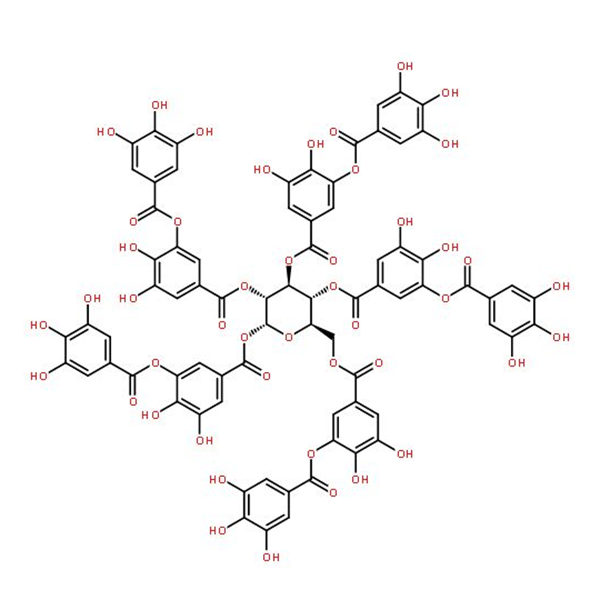
PRODUCTS CENTER
——
Gallic acid
Product DetailsSpecification DataApplication
Product name: Gallic acid
Chemical name: 3,4,5-trihydroxybenzoic acid
Structural formula: C7H6O5 / 170.12 g/mol
CAS: 149-91-7
Properties: This product is white or white crystalline powder, soluble in 85 parts of water, 6 parts of ethanol, 2 parts of boiling water, slightly soluble in ether.
| Items | Industrial grade | High-purity grade | Elctronic grade | ||||||||
| Appearance | White powder | White powder | Light white powder | ||||||||
| Assay % | ≥98.5% | ≥99.0% | ≥99.0% | ||||||||
| Loss on dring % | ≤10.0% | ≤10.0% | ≤10.0% | ||||||||
| Lgnition residue % | ≤0.1% | ≤0.1% | ≤0.1% | ||||||||
| Chloride % | ≤0.02% | ≤0.01% | ≤0.01% | ||||||||
| Sulphate % | ≤0.02% | ≤0.01% | ≤0.01% | ||||||||
| trace metal content(ppb)- High-purity grade & Elctronic grade | |||||||||||
| Test items | Specifications | Test result | Test items | Specifications | Test result | ||||||
| Al | ≤500 | ≤50 | Li | ≤500 | ≤50 | ||||||
| Au | ≤500 | ≤50 | Mg | ≤500 | ≤50 | ||||||
| Ag | ≤500 | ≤50 | Mn | ≤500 | ≤50 | ||||||
| B | ≤500 | ≤50 | Ni | ≤500 | ≤50 | ||||||
| Ba | ≤500 | ≤50 | Na | ≤500 | ≤50 | ||||||
| Cd | ≤500 | ≤50 | Pb | ≤500 | ≤50 | ||||||
| Ca | ≤500 | ≤100 | Sr | ≤500 | ≤50 | ||||||
| Cr | ≤500 | ≤50 | Sn | ≤500 | ≤50 | ||||||
| Co | ≤500 | ≤50 | Sb | ≤500 | ≤50 | ||||||
| Cu | ≤500 | ≤50 | Ta | ≤500 | ≤50 | ||||||
| Fe | ≤500 | ≤100 | Ti | ≤500 | ≤50 | ||||||
| Ga | ≤500 | ≤50 | Zn | ≤500 | ≤100 | ||||||
| K | ≤500 | ≤50 | |||||||||
Gallic acid, a naturally occurring phenolic compound, has gained substantial recognition across various industries for its versatile applications. This compound, available in different grades such as industrial, high purity, and electronic grade, plays a crucial role in the fields of chemical synthesis, industrial manufacturing, electronics, and even pharmaceuticals. Each grade of Gallic acid caters to specific needs, with the industrial form serving broad applications and the high-purity and electronic grades playing vital roles in advanced technological sectors.
Industrial Gallic Acid
Industrial-grade Gallic acid, primarily produced through the chemical synthesis of plant sources such as Gallnuts, is a key raw material in various manufacturing processes. One of the significant uses of this grade of Gallic acid is in the production of Gallic acid esters, which are highly valued for their antioxidant properties. These antioxidants are particularly useful in the food industry, where they are employed to slow the oxidation process and enhance the shelf life of products. In addition to their use in food preservation, Gallic acid esters also find applications in the cosmetic and pharmaceutical industries, where their antioxidative properties help prevent the degradation of active ingredients.
Another important application of industrial Gallic acid is in fuel manufacturing. Gallic acid derivatives are used as stabilizers in certain fuel types, providing enhanced stability and performance in various energy applications. In the fireworks industry, industrial-grade Gallic acid serves as a stabilizer for certain chemical compositions, contributing to more controlled and vibrant displays. Moreover, Gallic acid is involved in the production of blue and black ink, where its chemical properties facilitate the development of pigments that offer rich and durable colors. Its role as a stabilizing agent also makes it valuable in other areas, such as the preparation of sound agents for flute manufacturing, ensuring the production of consistent and high-quality sound.
In addition to these uses, Gallic acid has a significant presence in agriculture. As a plant growth regulator, it can influence the development of plants, improving crop yields and contributing to more sustainable farming practices. Furthermore, it serves as an ultraviolet (UV) ray absorber, protecting sensitive materials from UV degradation and enhancing the longevity of products exposed to sunlight. Another key application is in fire retardants, where Gallic acid derivatives are incorporated to reduce the flammability of various materials, providing an extra layer of safety in industrial and construction settings.
Industrial-grade Gallic acid also has a place in the tanning and photography industries. In the tanning process, Gallic acid is used to treat leather, improving its durability and appearance. In the photographic industry, it serves as a photographic developer, playing a crucial role in the development of images on photographic films. This dual function demonstrates the versatility of Gallic acid in both industrial and creative sectors, where its chemical properties enable a wide range of applications.
High Purity, Electronic Grade Gallic Acid
High-purity and electronic-grade Gallic acid are produced to meet the rigorous demands of the electronics and semiconductor industries. The synthesis of semiconductor materials is one of the primary applications for high-purity Gallic acid. Its precise chemical properties make it an ideal precursor for materials used in semiconductors, where it contributes to the creation of compounds with excellent electrical conductivity and stability. These semiconductor materials are crucial in the manufacturing of integrated circuits (ICs) and other electronic components that power modern technological devices such as smartphones, computers, and various household electronics.
Electronic grade Gallic acid plays an essential role in the cleaning and maintenance of electronic devices as well. In the electronics industry, integrated circuit boards require thorough cleaning to ensure optimal performance. Gallic acid, in its high-purity form, is used as a cleaning agent for these delicate components, removing impurities and ensuring that the circuits function without interference. This cleaning process is critical in maintaining the reliability and longevity of electronic devices, where even the smallest amount of contamination can lead to malfunctions or reduced efficiency.
Another application of high-purity Gallic acid is as an analytical reagent. It is used in various analytical techniques, where its chemical reactivity allows for the detection and quantification of different substances. For instance, Gallic acid can be employed to detect free inorganic acids, which are important in various chemical processes. Additionally, it is used in the detection of dihydroxyacetone, alkaloids, and metals, making it a versatile tool in the field of analytical chemistry. This broad applicability in chemical analysis further emphasizes the importance of high-purity Gallic acid in both scientific research and industrial applications.
Comparison of Applications
While both industrial-grade and high-purity Gallic acid serve essential roles in various sectors, their applications are markedly different due to the differences in purity and chemical properties. Industrial-grade Gallic acid is used extensively in large-scale manufacturing processes, where its relatively lower purity does not hinder its functionality. This form is indispensable in the production of antioxidants, stabilizers, inks, and other chemical compounds used in industries such as food processing, agriculture, and energy. Its versatility in industrial applications ensures that it remains a staple in these fields.
On the other hand, high-purity Gallic acid is tailored for more specialized applications that require precise chemical properties and minimal impurities. In the electronics and semiconductor industries, where the performance of materials is paramount, the use of Electronic grade Gallic acid is critical. Its role in the synthesis of semiconductor materials, cleaning of electronic components, and chemical analysis underscores its importance in high-tech industries. The high level of purity ensures that these processes proceed without the risk of contamination, which could lead to failures or inefficiencies in electronic devices.
Keyword: Gallic acid
Prev: Nothing!
Next: Methyl gallate
Product Inquiry
Related Products
Products
-

Gallic acid
Chemical name : 3,4,5-trihydroxybenzoic acid. Molecular formula:C₇H₆O₅ CAS: 149-91-7 It can be widely found in the nature, such as Rheum Palmatum, Swamp Mahogany, dogwood, etc. Gallic acid is widely applied in multiple fields such as food, biology, pharmaceutical, chemical industry, semiconductor, etc.
-

Methyl gallate
Chemical name : 3,4,5-trihydroxybenzoate. CAS:99-24-1; Chemical formula:C₈H₈O₅. It is widely applied in multiple fields such as food, biology, pharmaceutical, chemical industry, semiconductor, etc.
-

Propyl gallate
Chemical name: 3,4,5-trihydroxybenzoate. CAS:121-79-9; Molecular formula : C₁₀H₁₂O₅. It is used as an antioxidant additive in industries like food pharmaceutical, cosmetic, hair care product, feed and semiconductor; and as a stabilizer in manufacturing of green fiber and a rubber antioxidant.
-

Pyrogallol
Pyrogallol is also called pyrogallic acid. Chemical name: 1,2,3-trihydroxy benzene. CAS:87-66-1 Molecular formula :C₆H₆O₃. It is obtained by decarboxylic reaction of gallic acid.
-

Tannic acid
Tannic acid also called tannin is an organic compound. CAS:1401-55-4 Chemical formula: C₇₆H₅₂O₄₆. Tannic acid can be used for making gallic acid.

